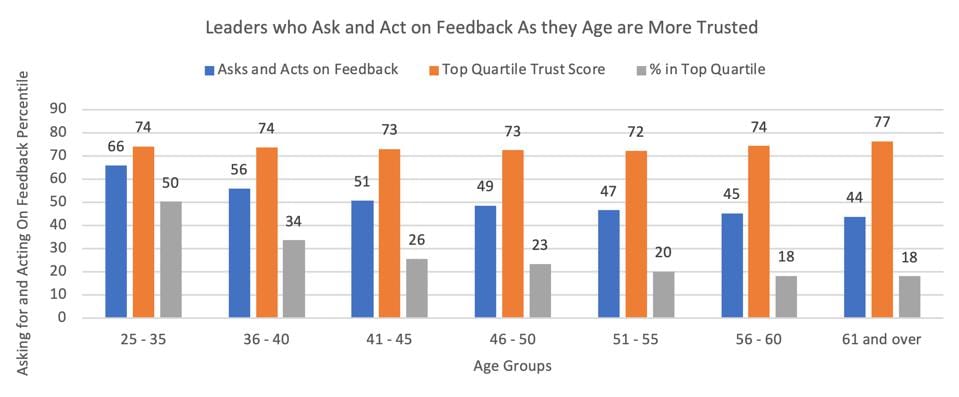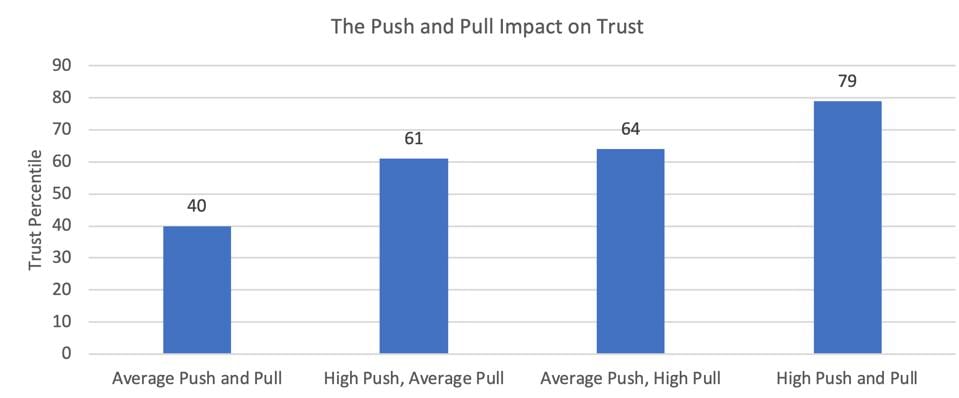6 top behaviors that cause a loss of trust

Leaders Under Pressure: Finding The Essential Skills For The New Era

Research: Women Are Better Leaders During a Crisis


At Zenger Folkman, we looked at 360-degree feedback data collected from over 85,000 leaders and identified those whose trust score was in the bottom 10% as rated by managers, peers, direct reports, and others. The list below contains some of the negative impacts of a loss of trust.
- Overall Leadership Effectiveness is rated at the 13th percentile.
- Employee Engagement of their direct reports is at the 30th percentile.
- 42% of direct reports are thinking about quitting.
- Only 7% of direct reports are willing to put forth the extra effort.
- Only 5% of the untrusted leaders were part of the high potential pool.
When trust is lost, effectiveness is gone, direct reports are disengaged, and many people are looking for a way out.
What are the significant causes of distrust for leaders?
By doing additional analysis on the dataset, we were able to identify the main factors that lead to a loss of trust. The elements are listed in order of their impact.
- Damaged relationships.At the top of the list, we found that when relationships are damaged, trust is lost. People do not trust those they dislike. Several years ago, I coached a division president who had very low scores in trust. When I enquired why his results were so negative, he replied, “I avoid developing positive relationships with my team because I never know when I am going to have to fire one of them.” The only problem with his approach was that his poor relationship with team members caused most of them to quit before he could fire them. Team members do not need to be a leader’s best friend, but they do need to be respected, valued, and feel that their manager has their back.
- Words not matching actions. In other words, saying one thing and doing another. Duplicity also destroys trust. Many leaders are unaware of their duplicity because of a tendency to tell others what they want to hear instead of providing them with accurate feedback. In a meeting, Janet asked her manager, “How am I doing in my job so far?” The manager replied, “Great.” What Janet heard was that there was no problem with her performance. A few weeks later, Janet had a performance review with her manager. In the discussion, her manager mentioned a few areas where Janet could improve her performance. The manager’s feedback was a big surprise, and Janet’s conclusion about her manager was that the manager was duplicitous. Many leaders tend to over promise and under deliver, and when that happens, trust is lost. Leaders need to be careful about what they say because direct reports will remember everything.
- Poor judgment. We trust people who have knowledge and expertise that we do not have. Sharing your expertise and knowledge can build trust in others. Giving others inaccurate or misleading information will cause them to lose trust quickly. It is impossible for leaders to have all the answers and to be knowledgeable about every issue. Problems arise when leaders give their uninformed opinions as if they are facts. It’s easy for leaders to avoid this problem if they will only involve others and gather data from the more knowledgeable experts.
- Uncooperative. Many people have a strong desire to act independently. By acting alone, they can make their own decisions, avoid distractions from others, and they can take full credit for their accomplishments. The problem with people who want to act independently is that organizations only work well when people find ways to cooperate and collaborate. Those who resist cooperation and prefer their independence are not as trusted.
- Not open to feedback and unwilling to change. There is a strong correlation between age and willingness to ask for and act on feedback. When people first start working, they typically ask for a lot of feedback from others. As they age, their willingness to ask for feedback decreases. Those who continue to ask for feedback throughout their career end up being more trusted. In the study below, we looked at data from over 62,000 leaders. Note that the effectiveness of asking for and acting on feedback (the first bar) decreases as leaders age. Leaders, on average, are less effective at asking for feedback but not every leader. The second bar shows the average trust score for those in the top quartile on asking and acting on feedback. Note that those scores do not decrease with age, but there is a small increase. The third bar represents the percentage of people in the top quartile on “asks for and acts on feedback.” These percentages decrease from 50% at age 25-35, and 18% at 61 years and older. The point of this study demonstrates that those who continue to ask for feedback as they age are more trusted.

- Uninspiring.Most people know how to push others to do things. They are focused on delivering results. Those leaders who only “push” and don’t know how to “pull” end up losing the trust of others. Those that know how to pull, start by creating positive emotional connections with others. Rather than demand that team members work harder, inspiring leaders find ways to get their people excited about accomplishing a difficult goal. In the study below, we examined 360 data from 85,904 leaders. We examined the impact of effectiveness on push (Drive for Results) and pull (Inspiring and Motivating Others) on trust. Average scores were those below the 75th percentile, while high scores were those in the top quartile. Note that when both push and pull are average, trust is at the 49th percentile (10 percentile points below average). Moving either push or pull into the top quartile improves trust, but improving both puts trust into the 79th percentile! The point this study makes is that leaders do not need to stop pushing and only start pulling to build trust. The secret to having the highest levels of trust is to both push and pull.

Restoring Trust
Improvement in any of these behaviors will help to restore trust, but leaders who have lost trust need to start the restoration process by making a public and sincere acknowledgment of their faults. Letting others know that a leader feels sorry for past mistakes allows them to reset their expectations. When you are driving down the freeway with other vehicles and you notice a car in front of you shifting into your lane, what you want to see is a turn signal light. This assures you that another car is moving into your lane. Signaling your intention lets others know that you want to change lanes. Start now by signaling your intention to increase trust. Then decide which areas you can improve.
-Joe Folkman
Source : zengerfolkman.com



